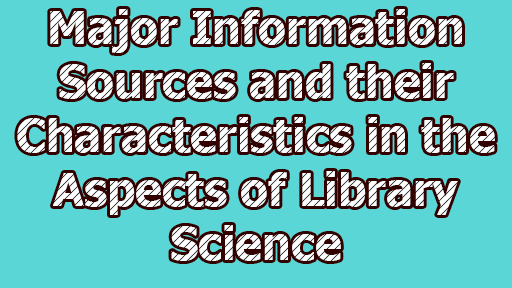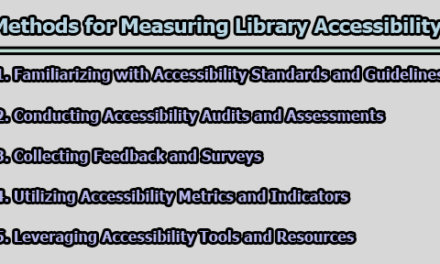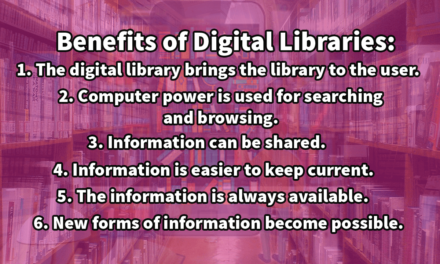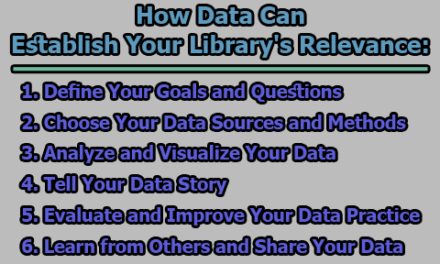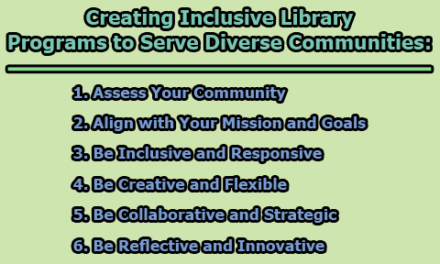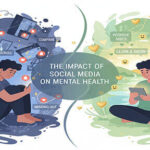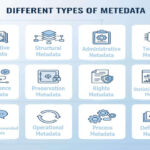Major Information Sources and their Characteristics in the Aspects of Library Science:
Libraries are not only repositories of books but serve as hubs of knowledge, providing resources that support education, research, and leisure activities for their users. Information sources play a crucial role in meeting the diverse information needs of library users and facilitating access to reliable and relevant materials. In the rest of this article, we are going to know about the major information sources and their characteristics in the aspects of library science.
1. Traditional Information Sources:
This section focuses on traditional information sources that have been fundamental to library collections for centuries.
1.1 Books:
Books have long been regarded as one of the most fundamental and traditional sources of information. They provide in-depth coverage of a wide range of topics and can vary in format, including textbooks, monographs, reference books, and literature. Books offer a comprehensive and structured approach to information, presenting concepts, theories, and research findings in a coherent manner.
Libraries maintain extensive collections of books, catering to the diverse interests and information needs of their users. They acquire books through purchases, donations, and interlibrary loan programs. Books offer several advantages, such as being portable, durable, and accessible without the need for electronic devices or internet access. They are particularly valuable for in-depth research, historical information, and foundational knowledge in various fields.
1.2 Journals and Periodicals:
Journals and periodicals are publications that regularly release new issues containing articles, research papers, and other scholarly contributions. They provide the latest research findings, expert opinions, and analysis within specific subject areas. Journals are often peer-reviewed, ensuring the quality and reliability of the information they contain.
Libraries subscribe to a wide range of journals and periodicals, both in print and electronic formats, to provide access to current research and developments in various disciplines. Researchers and professionals rely on journals to stay updated with the latest advancements, follow trends, and engage in scholarly discourse. Libraries often organize journals in databases, making them easily searchable and accessible to users.
1.3 Newspapers:
Newspapers are a traditional and valuable source of current and timely information. They report on local, national, and international news, providing coverage of politics, economics, social issues, sports, entertainment, and more. Newspapers offer a snapshot of the world’s events, opinions, and public discourse.
Libraries collect and archive newspapers, often in microfilm or digital formats, to ensure their preservation and accessibility. Researchers and historians rely on newspapers for historical research, tracking trends, and gaining insights into specific time periods. Newspapers can offer diverse perspectives, presenting a range of opinions and viewpoints on important events and issues.
1.4 Reference Materials:
Reference materials encompass a variety of resources designed for quick and concise information retrieval. These materials include encyclopedias, dictionaries, atlases, almanacs, handbooks, and directories. They provide factual information, definitions, explanations, statistics, and other reference data.
Libraries maintain reference collections, both in print and electronic formats, to support users’ immediate information needs. Reference materials are valuable for general knowledge, quick fact-checking, background information, and initial research. They offer a reliable starting point for research projects, providing essential context and overview of topics.
1.5 Theses and Dissertations:
Theses and dissertations are research works submitted by students to fulfill academic requirements for advanced degrees, such as master’s or doctoral degrees. They represent original research conducted by the authors and contribute to the body of knowledge within their respective fields.
Libraries collect and preserve theses and dissertations, often in print and digital formats, to make them available for future researchers. Theses and dissertations are valuable sources of specialized research, presenting detailed methodologies, data analysis, and conclusions. They can be beneficial for researchers seeking in-depth studies on specific topics.
1.6 Manuscripts and Archives:
Manuscripts and archives refer to unique and historical documents, letters, diaries, photographs, maps, and other primary source materials. They provide firsthand accounts, personal narratives, and unique perspectives on various historical events, individuals, and cultural aspects.
Libraries, archives, and special collections preserve and provide access to manuscripts and archives, ensuring their long-term preservation and availability for research purposes. These materials are often used by historians, researchers, and individuals interested in studying specific time periods, historical figures, or cultural heritage. They offer valuable insights into past events, cultural practices, and intellectual traditions.
1.7 Almanacs:
Almanacs are annual publications that provide a wealth of factual information on various topics. They typically include calendars, astronomical data, weather forecasts, statistical information, and other general knowledge.
Libraries often acquire almanacs to provide users with up-to-date information on a wide range of subjects, such as agriculture, sports, economics, and demographics. Almanacs serve as handy reference sources for quick facts, historical data, and statistical information. They are particularly useful for researchers, journalists, trivia enthusiasts, and individuals seeking general knowledge in a concise and easily accessible format.
1.8 Dictionaries:
Dictionaries are comprehensive reference works that provide definitions, spellings, pronunciations, etymologies, and usage examples of words in a particular language or specialized field. They serve as authoritative sources for understanding and clarifying language meanings and usages.
Libraries maintain dictionaries in various formats, including print and electronic versions, to support language learning, research, writing, and general reference needs. Dictionaries are valuable tools for students, language learners, writers, and individuals seeking accurate and reliable definitions of words and phrases. They offer guidance on proper usage, synonyms, antonyms, and idiomatic expressions, facilitating effective communication and language comprehension.
1.9 Yearbooks:
Yearbooks, also known as annuals or annuaries, are publications that provide a comprehensive summary of events, achievements, and information for a specific year or period. They often include photographs, lists of notable individuals, statistics, and highlights of significant developments.
Libraries collect yearbooks to preserve historical records and provide access to information about specific institutions, organizations, communities, or industries. Yearbooks serve as valuable resources for researchers, genealogists, historians, and individuals interested in tracing the history, activities, and people associated with a particular time and place.
1.10 Conference Proceedings:
Conference proceedings are collections of papers, presentations, and abstracts that document the proceedings and outcomes of academic conferences, symposiums, and professional meetings. They provide access to the latest research findings, scholarly discussions, and advancements in specific fields or disciplines.
Libraries acquire conference proceedings to support research, keep track of academic discourse, and provide access to cutting-edge knowledge. They are valuable resources for researchers, scholars, and professionals seeking information on recent research, emerging trends, and collaborations within their fields of interest. Conference proceedings often include unpublished research, preliminary findings, and discussions on specialized topics, making them valuable sources for staying abreast of the latest developments.
2. Digital Information Sources:
As technology has advanced, digital information sources have become increasingly prevalent in library science. This section explores the characteristics of digital sources and their impact on libraries.
2.1 Online Databases:
Online databases are vast collections of digital resources that provide access to scholarly articles, research papers, book chapters, conference proceedings, and other publications. These databases cover a wide range of disciplines and subject areas, allowing users to search for and retrieve relevant information.
Libraries subscribe to online databases such as JSTOR, ProQuest, PubMed, and IEEE Xplore, among others, to provide users with access to high-quality, peer-reviewed literature. These databases offer advanced search functionalities, citation tracking, and often provide full-text access to articles. Online databases are valuable resources for researchers, students, and professionals seeking scholarly information and staying up-to-date with the latest research in their fields.
2.2 E-books and E-journals:
E-books and e-journals are digital versions of books and journals that can be accessed and read electronically. They offer convenient and instant access to a wide range of academic and professional publications.
Libraries acquire e-books and subscribe to e-journal collections to provide users with access to a vast selection of digital reading materials. E-books can be accessed through platforms like OverDrive, EBSCOhost, or Kindle, while e-journals are available through publishers’ platforms or aggregators. These digital sources offer features such as keyword searching, bookmarking, and hyperlinked references, enhancing the reading experience and facilitating research.
2.3 Digital Repositories and Institutional Repositories:
Digital repositories, also known as digital libraries or institutional repositories, are online platforms that store and provide access to digital collections of scholarly works, research data, theses, dissertations, and other materials. They aim to preserve and disseminate the intellectual output of an institution or a specific community.
Libraries create and manage digital repositories to host locally produced content, including faculty publications, student theses, and research data. These repositories often use open-access principles, making the content freely available to the public. Digital repositories promote open scholarship, increase the visibility of research outputs, and facilitate long-term preservation and access to scholarly materials.
2.4 Online Catalogs and OPACs:
Online catalogs and Online Public Access Catalogs (OPACs) are digital interfaces that allow users to search and access the library’s physical and digital collections. They provide information about the library’s holdings, including books, journals, multimedia resources, and more.
Libraries use integrated library systems (ILS) or library management software to create and maintain online catalogs. Users can search for specific titles, authors, subjects, or keywords to locate materials within the library’s collections. Online catalogs and OPACs enable users to check the availability of items, place holds, renew materials, and access digital resources, enhancing the overall user experience and facilitating efficient resource discovery.
2.5 Online Reference Sources:
Online reference sources encompass digital encyclopedias, dictionaries, directories, and other reference materials available on the web. These sources provide quick access to reliable information, definitions, explanations, and background knowledge.
Libraries subscribe to online reference databases such as Encyclopedia Britannica Online, Oxford Reference, and Merriam-Webster Online, among others. These databases offer a wealth of information across various subject areas, including history, science, literature, and more. Online reference sources are valuable for general knowledge, quick fact-checking, and initial research, providing users with authoritative and up-to-date information.
2.6 Digital Archives and Cultural Heritage Collections:
Digital archives and cultural heritage collections involve the digitization and preservation of historical documents, photographs, manuscripts, artworks, and other artifacts. These collections provide online access to valuable cultural, historical, and artistic resources.
Libraries collaborate with cultural institutions, museums, and archives to digitize and provide access to these collections. Examples of digital archives include the Digital Public Library of America (DPLA) and Europeana, which offer a vast array of digitized materials from libraries, museums, and archives worldwide. Digital archives and cultural heritage collections enable researchers, historians, and the general public to explore and engage with primary source materials from various time periods and geographic regions.
2.7 Online News Sources:
Online news sources encompass digital platforms of newspapers, magazines, and news agencies that offer current and archived news content. These sources provide up-to-date information on local, national, and international events, politics, business, sports, entertainment, and more.
Libraries subscribe to online news databases like Factiva, LexisNexis, or ProQuest Newsstand to provide users with access to a wide range of news publications. These databases offer search capabilities, allowing users to retrieve articles based on keywords, dates, or specific publications. Online news sources are valuable for staying informed, conducting current affairs research, and accessing diverse perspectives on important issues.
2.8 Online Learning Resources:
Online learning resources encompass educational platforms, e-learning modules, online courses, and video lectures that support learning and professional development. These resources offer a flexible and accessible way to acquire new knowledge and skills.
Libraries collaborate with educational institutions and online learning platforms to provide access to these resources. Platforms like Coursera, Khan Academy, and Lynda.com offer a wide range of courses and tutorials on various subjects. Online learning resources enable users to engage in self-paced learning, acquire new skills, and enhance their professional growth.
2.9 Digital Image Collections:
Digital image collections consist of digitized images and artworks from various sources, including museums, galleries, libraries, and archives. These collections provide high-resolution images of paintings, photographs, sculptures, and other visual materials.
Libraries collaborate with cultural institutions and organizations to provide access to digital image collections. Examples include the Digital Public Library of America (DPLA), Wikimedia Commons, and the Artstor Digital Library. These collections enable users to explore and study artworks, historical photographs, and visual materials without the need for physical access. Digital image collections are valuable for art historians, researchers, and individuals interested in visual culture, providing access to rare and iconic images from around the world.
2.10 Open Educational Resources (OER):
Open Educational Resources (OER) are freely accessible teaching and learning materials that can be used, shared, and modified by educators and learners. OER encompass textbooks, lecture notes, multimedia resources, lesson plans, and interactive learning modules.
Libraries actively promote and provide access to OER to support affordable and open education. OER repositories, such as OER Commons and MERLOT, offer a wide range of educational materials across different disciplines and grade levels. These resources empower educators to customize their teaching materials, facilitate collaboration, and reduce the cost of educational resources. OER are valuable for students, teachers, and lifelong learners seeking quality educational materials without financial barriers.
2.11 Social Media and Blogs:
Social media platforms and blogs have become significant sources of information and communication. They provide a space for individuals and organizations to share ideas, opinions, news, and resources.
Libraries leverage social media platforms, such as Twitter, Facebook, and Instagram, to engage with users, promote library services and resources, and share relevant information. Libraries also host blogs to publish articles, book reviews, research guides, and other content of interest to their users. Social media and blogs enable libraries to reach a broader audience, foster community engagement, and provide timely updates and information.
2.12 Multimedia Resources:
Multimedia resources refer to digital content that combines different formats such as text, images, audio, video, and interactive elements. These resources offer engaging and interactive learning experiences.
Libraries acquire and provide access to multimedia resources, including educational videos, interactive tutorials, audio recordings, and online multimedia collections. Platforms like YouTube Edu, Khan Academy, and TED Talks offer a wide range of multimedia content that supports teaching, learning, and research. Multimedia resources are valuable for visual learners, students in creative fields, and those seeking dynamic and immersive learning experiences.
2.13 Online Forums and Discussion Boards:
Online forums and discussion boards are web-based platforms that facilitate discussions, knowledge sharing, and collaboration among users. These platforms provide opportunities for individuals with shared interests to connect, ask questions, and share insights.
Libraries create and moderate online forums and discussion boards as part of their virtual community engagement initiatives. These platforms enable library patrons to seek assistance, share information, and engage in discussions related to specific topics or library services. Online forums and discussion boards foster a sense of community and provide an avenue for users to connect with experts, librarians, and peers to exchange ideas and seek support.
3.14 Virtual Reference Services:
Virtual reference services are online platforms or systems that allow users to seek assistance and receive reference support from librarians remotely. These services offer real-time interactions through chat, email, or video conferencing, providing users with access to expert guidance and information resources.
Libraries implement virtual reference services to extend their reference services beyond physical locations. Users can ask questions, seek research assistance, and get help with information inquiries from qualified librarians. Virtual reference services ensure that users have access to personalized assistance and reliable information, regardless of their geographical location.
3. Specialized Information Sources:
This section explores specialized information sources that are particularly relevant to library science.
3.1 Subject-Specific Databases:
Subject-specific databases focus on particular disciplines or subject areas, providing in-depth and specialized information. These databases cater to the research needs of specific academic fields, such as medicine, engineering, social sciences, or humanities. They offer a vast collection of scholarly articles, conference papers, research reports, and other relevant materials specific to the subject area.
Subject-specific databases often provide advanced search features tailored to the discipline, allowing users to refine their queries based on specific criteria, such as keywords, authors, publication dates, or study methodologies. These databases are curated and maintained by experts in the respective fields, ensuring the quality and relevance of the information. Libraries subscribe to subject-specific databases to provide their users with access to authoritative and discipline-specific resources.
3.2 Legal Information Sources:
Legal information sources focus on providing access to laws, regulations, court cases, legal commentary, and other legal documents. These sources include legal databases, legal encyclopedias, legal dictionaries, and legal research platforms. They serve legal professionals, researchers, and individuals seeking legal information or conducting legal research.
Legal information sources often provide access to primary legal materials, such as statutes and regulations, as well as secondary sources, including legal treatises and law reviews. They may include features such as case citation tools, cross-referencing, and advanced search capabilities specific to legal research. Libraries often provide access to legal information sources to support legal research, education, and the general public’s understanding of the law.
3.3 Medical and Health Information Sources:
Medical and health information sources cater to the specific information needs of healthcare professionals, researchers, and individuals interested in health-related topics. These sources include medical databases, clinical guidelines, drug information databases, medical textbooks, and research journals.
Medical and health information sources offer comprehensive and up-to-date information on diseases, medical procedures, drug interactions, patient care, and other related topics. They often provide access to evidence-based research, clinical trials, and diagnostic tools. Libraries acquire and provide access to medical and health information sources to support medical education, patient care, and health research initiatives.
3.4 Statistical Databases:
Statistical databases compile and provide access to statistical data on a wide range of subjects, including demographics, economics, education, health, and social indicators. These databases often collect data from government agencies, international organizations, research institutions, and surveys.
Statistical databases offer tools and interfaces that allow users to manipulate, analyze, and visualize data. They provide access to raw data as well as pre-generated tables, charts, and graphs. Libraries acquire and provide access to statistical databases to support research, policy-making, and data-driven decision-making across various disciplines.
3.5 Patent and Intellectual Property Databases:
Patent and intellectual property databases offer access to patent documents, trademarks, copyright information, and other intellectual property resources. These databases are crucial for researchers, inventors, legal professionals, and businesses interested in intellectual property rights and innovation.
Patent and intellectual property databases provide comprehensive search capabilities, allowing users to explore patent filings, examine patent claims, and assess the novelty and prior art related to inventions. They may also offer features such as patent citation analysis and intellectual property management tools. Libraries acquire and provide access to patent and intellectual property databases to support innovation, research, and intellectual property-related activities.
3.6 Business and Market Research Sources:
Business and market research sources cater to the needs of entrepreneurs, business professionals, marketers, and researchers seeking information on industries, market trends, consumer behavior, and competitive intelligence. These sources include business databases, market research reports, financial data platforms, and industry profiles.
Business and market research sources provide access to company profiles, financial statements, market research studies, industry analysis, and other relevant business information. They often offer data visualization tools, benchmarking features, and forecasting capabilities. Libraries acquire and provide access to business and market research sources to support entrepreneurship, business development, and market analysis.
3.7 Engineering and Technical Information Sources:
Engineering and technical information sources cater to the information needs of engineers, scientists, and researchers in various technical fields. These sources include engineering databases, technical standards, patents, technical reports, and specialized journals.
Engineering and technical information sources provide access to scientific literature, research papers, technical specifications, and data related to specific engineering disciplines such as civil engineering, mechanical engineering, electrical engineering, and more. They often offer advanced search features, specialized indexing, and tools for data analysis and visualization. Libraries acquire and provide access to engineering and technical information sources to support research, innovation, and technical advancements.
3.8 Geographic Information Systems (GIS) and Mapping Sources:
Geographic Information Systems (GIS) and mapping sources focus on spatial data, maps, and geographic information. These sources include GIS software, geospatial databases, digital maps, aerial imagery, and topographic data.
GIS and mapping sources provide access to spatial datasets, allowing users to analyze and visualize geographical information. They are essential for various applications such as urban planning, environmental studies, transportation, and disaster management. Libraries acquire and provide access to GIS and mapping sources to support research, geospatial analysis, and decision-making processes that involve geographical data.
3.9 Genealogical and Historical Information Sources:
Genealogical and historical information sources cater to individuals interested in tracing their family history, conducting historical research, or exploring historical records and documents. These sources include genealogical databases, archival collections, historical newspapers, and specialized historical research tools.
Genealogical and historical information sources provide access to census records, birth and death records, immigration records, military records, and other historical documents. They often offer search features specific to genealogical research, such as surname searches and family tree building tools. Libraries acquire and provide access to genealogical and historical information sources to support genealogical research, local history studies, and historical preservation efforts.
3.10 Education Resources:
Education resources focus on providing access to educational materials, pedagogical research, curriculum resources, and educational policies. These sources include educational databases, scholarly journals in education, curriculum repositories, and educational research reports.
Education resources offer access to scholarly articles, research studies, lesson plans, assessment tools, and policy documents in the field of education. They are essential for teachers, educators, researchers, and policymakers seeking to enhance teaching practices, develop curricula, and stay updated with educational trends. Libraries acquire and provide access to education resources to support teaching, learning, and educational research.
3.11 Linguistics and Language Resources:
Linguistics and language resources cater to researchers, linguists, and language professionals interested in the study of language and linguistic analysis. These sources include linguistic databases, corpora, dictionaries, language documentation archives, and specialized linguistic journals.
Linguistics and language resources provide access to linguistic data, language samples, lexical databases, and resources for language analysis. They are essential for research on language structure, sociolinguistics, computational linguistics, translation studies, and language documentation. Libraries acquire and provide access to linguistics and language resources to support linguistic research, language preservation efforts, and language-related studies.
3.12 Music and Performing Arts Resources:
Music and performing arts resources cater to musicians, performers, musicologists, and researchers in the field of performing arts. These sources include music databases, sheet music collections, audio and video recordings, music scores, and performing arts journals.
Music and performing arts resources offer access to music compositions, performance recordings, music theory resources, and scholarly articles on music and performing arts. They are essential for music education, performance studies, musicology research, and appreciation of the arts. Libraries acquire and provide access to music and performing arts resources to support music education, research, and cultural enrichment.
3.13 Environmental and Sustainability Information Sources:
Environmental and sustainability information sources focus on providing access to resources related to environmental studies, ecology, conservation, and sustainability. These sources include environmental databases, research reports, environmental impact assessments, policy documents, and scientific journals.
Environmental and sustainability information sources offer access to research findings, environmental data, climate change reports, and best practices in sustainable development. They are essential for researchers, policymakers, and environmental professionals seeking to address environmental challenges and promote sustainable practices. Libraries acquire and provide access to these sources to support environmental research, education, and advocacy.
3.14 Social Sciences and Humanities Archives:
Social sciences and humanities archives preserve and provide access to historical and cultural materials related to social sciences, humanities, and the arts. These archives may include manuscripts, diaries, letters, photographs, oral history recordings, and other primary sources.
Social sciences and humanities archives serve as repositories of unique and valuable resources for researchers, historians, and individuals interested in studying the social and cultural aspects of human society. They offer insights into past events, cultural practices, and intellectual traditions. Libraries collaborate with archives, cultural institutions, and community organizations to digitize, preserve, and provide access to these archival materials.
3.15 Government Documents and Public Policy Sources:
Government documents and public policy sources focus on providing access to official publications, legislative materials, government reports, and policy documents. These sources include government databases, legislative libraries, official gazettes, and public policy research institutes.
Government documents and public policy sources are crucial for researchers, policymakers, and individuals interested in understanding government actions, policies, and regulations. They offer access to legislation, policy briefs, research studies, and government statistics. Libraries acquire and provide access to government documents and public policy sources to support research, policy analysis, and informed decision-making.
3.16 Agricultural and Food Science Information Sources:
Agricultural and food science information sources cater to researchers, practitioners, and policymakers in the field of agriculture, food production, and agribusiness. These sources include agricultural databases, crop research reports, agricultural journals, food safety guidelines, and agricultural market information.
Agricultural and food science information sources provide access to research findings, agricultural techniques, crop data, food production standards, and market trends. They support agricultural research, sustainable farming practices, and food security initiatives. Libraries acquire and provide access to agricultural and food science sources to support agricultural education, research, and innovation.
3.17 Psychology and Behavioral Sciences Information Sources:
Psychology and behavioral sciences information sources focus on providing access to research articles, psychological assessments, therapy techniques, and resources related to human behavior and mental health. These sources include psychology databases, psychotherapy manuals, psychological testing resources, and mental health journals.
Psychology and behavioral sciences information sources offer access to research studies, theoretical frameworks, therapeutic interventions, and psychological assessment tools. They support psychological research, clinical practice, counseling, and mental health promotion. Libraries acquire and provide access to psychology and behavioral sciences sources to support psychology education, research, and mental health services.
3.18 Cultural Heritage and Museum Collections:
Cultural heritage and museum collections encompass digitized materials and resources related to art, history, archaeology, and cultural artifacts. These sources include digital collections of museums, cultural institutions, and archival repositories.
Cultural heritage and museum collections provide access to digitized artworks, historical documents, archaeological artifacts, and virtual exhibitions. They offer valuable resources for researchers, historians, art enthusiasts, and individuals interested in exploring cultural heritage. Libraries collaborate with museums and cultural organizations to digitize, preserve, and provide access to these collections, ensuring their availability for research, education, and public engagement.
3.19 STEM Education Resources:
STEM (Science, Technology, Engineering, and Mathematics) education resources focus on providing access to educational materials, lesson plans, activities, and resources for STEM educators and students. These sources include STEM curriculum repositories, online learning platforms, and STEM-focused educational websites.
STEM education resources offer a wide range of materials and interactive tools to support teaching and learning in STEM subjects. They include lesson plans, experiments, simulations, and multimedia resources that promote hands-on learning and inquiry-based approaches. Libraries acquire and provide access to STEM education resources to support STEM education initiatives, enhance teaching practices, and foster interest in STEM fields.
3.20 Data Repositories and Data Curation Services:
Data repositories and data curation services cater to the needs of researchers and organizations working with large datasets and research data management. These sources include institutional data repositories, discipline-specific data repositories, and data curation platforms.
Data repositories and data curation services offer a platform for storing, sharing, and preserving research data. They ensure the long-term accessibility and usability of research data by providing metadata, data documentation, and data preservation services. Libraries play a vital role in providing data repositories and curation services, supporting researchers in complying with data management best practices and facilitating data sharing and reuse.
4. Characteristics of Information Sources:
Information sources possess various characteristics that define their nature and usefulness. These characteristics play a crucial role in determining the reliability, relevance, and accessibility of the information they provide. Here are the key characteristics of information sources:
4.1 Authority:
The authority of an information source refers to the credibility and expertise of the individuals or organizations responsible for creating or publishing the information. Authoritative sources are reliable and trustworthy, providing accurate and well-researched information. They are often written by subject matter experts, scholars, or reputable institutions with established expertise in the field. Assessing the authority of an information source helps users determine its reliability and the extent to which they can rely on the information it presents.
4.2 Accuracy:
Accuracy is a critical characteristic of information sources. Accurate sources provide information that is free from errors, factual inaccuracies, or misleading content. Reliable sources undergo thorough fact-checking processes, rely on credible evidence and sources, and strive to present information in an objective and unbiased manner. Users should verify the accuracy of information by cross-referencing it with multiple sources and evaluating the supporting evidence and references provided.
4.3 Currency:
Currency refers to the timeliness and up-to-dateness of the information. Information sources should be current and reflect the latest developments, research findings, and trends in the field. This is particularly important in rapidly evolving disciplines or when dealing with time-sensitive topics. Currency can be evaluated by checking the publication or creation date of the information source and assessing whether it aligns with the user’s specific information needs.
4.4 Relevance:
Relevance pertains to the extent to which the information source addresses the specific information needs or research questions of the user. A relevant information source provides information that is directly related to the user’s topic of interest, research objectives, or information requirements. Evaluating relevance involves assessing the scope, focus, and applicability of the information source in relation to the user’s specific context.
4.5 Objectivity:
Objectivity refers to the impartiality and lack of bias in the information source. Objective sources present information in a neutral and unbiased manner, allowing users to form their own opinions and interpretations. Objective sources strive to provide balanced perspectives, supported by evidence and logical reasoning, without promoting a particular agenda or point of view. Users should be cautious of sources that exhibit bias, personal opinion, or conflicts of interest.
4.6 Accessibility:
Accessibility refers to the ease of obtaining and accessing the information source. It encompasses factors such as availability, affordability, and user-friendly access methods. An accessible information source is one that is readily available to users, whether in physical or digital formats. Libraries and information professionals play a crucial role in ensuring the accessibility of diverse information sources to meet the needs of their users.
4.7 Coverage:
Coverage refers to the breadth and depth of the information provided by an information source. Comprehensive sources offer extensive coverage of a particular topic, providing in-depth analysis, multiple perspectives, and a wide range of relevant information. The level of coverage can vary depending on the type of source, ranging from general overviews to highly specialized and focused materials. Evaluating coverage helps users determine if the information source meets their information requirements and provides a comprehensive understanding of the topic.
4.8 Usability:
Usability refers to the ease with which users can navigate, understand, and utilize the information source. A usable source is well-organized, logically structured, and accompanied by clear instructions or guides. Usability considerations include the organization of content, search functionality, user interface design, and supplementary features such as indexes, glossaries, or citations. Usability is particularly important for digital information sources, as intuitive interfaces and user-friendly features enhance the overall user experience.
4.9 Peer Review:
Peer review is a process through which scholarly or academic information sources undergo rigorous evaluation by experts in the field before publication. Peer-reviewed sources have been critically evaluated for their quality, accuracy, and adherence to scholarly standards. This characteristic is particularly important when accessing academic journals, conference proceedings, and scholarly books, as peer review ensures the reliability and academic rigor of the information presented.
4.10 Depth:
The depth of an information source refers to the level of detail and comprehensiveness of the information provided. Some sources offer a broad overview of a topic, providing general information and key concepts, while others delve into intricate details and advanced analysis. The depth of an information source depends on its intended audience, purpose, and scope. Users should consider the level of depth required for their specific information needs and seek sources that align with their desired level of detail.
4.11 Metadata:
Metadata refers to descriptive information about an information source, such as its title, author, publication date, subject, keywords, and abstract. Metadata provides essential details that aid in the identification, organization, and retrieval of information. Libraries and digital repositories employ metadata standards and cataloging practices to ensure accurate and consistent metadata for their collections. Users can leverage metadata to assess the relevance and suitability of an information source for their specific needs, and librarians use metadata to facilitate efficient and effective information discovery.
4.12 Bias and Perspective:
Every information source possesses a certain degree of bias or perspective, shaped by the author’s background, context, or purpose. Understanding the bias and perspective of an information source is crucial for critically evaluating and interpreting the information presented. Users should be aware of potential biases and consider seeking multiple sources with different perspectives to develop a more comprehensive understanding of a topic. Libraries strive to provide a diverse range of information sources that encompass various viewpoints to support users’ exploration and critical analysis.
In conclusion, information sources play a vital role in library science, providing valuable resources that support research, learning, and the dissemination of knowledge. These sources can be categorized into traditional, digital, and specialized categories, each offering unique characteristics that shape their reliability, accessibility, and relevance.
Traditional information sources, such as books, journals, and physical archives, have long been the foundation of library collections. They provide in-depth, authoritative content and contribute to the preservation of cultural heritage. However, they may pose challenges in terms of accessibility and currency.
Digital information sources have emerged as powerful tools in the digital age, offering vast repositories of information that are easily accessible, up-to-date, and searchable. Digital libraries, databases, and online resources provide users with convenience, a wide range of formats, and interactive features. However, digital sources require careful evaluation to ensure accuracy, objectivity, and reliability.
Specialized information sources cater to specific domains, such as subject-specific databases, government portals, and institutional repositories. These sources provide focused and in-depth information, often curated by experts in the respective fields. They enhance precision and efficiency in information retrieval, but users need to be aware of the scope and limitations of these specialized sources.
When evaluating information sources, it is essential to consider key characteristics such as authority, accuracy, currency, relevance, objectivity, accessibility, coverage, usability, and peer review. These characteristics help users assess the reliability, credibility, and suitability of information sources to meet their specific needs.
Libraries and information professionals play a critical role in curating, organizing, and providing access to a diverse range of information sources. They guide users in navigating through the vast landscape of information, teach information literacy skills, and assist in source evaluation. By understanding the characteristics of information sources, users can make informed decisions, critically analyze information, and effectively utilize resources to advance their research and learning.
In the dynamic and evolving field of library science, embracing a combination of traditional and digital information sources, while being mindful of their characteristics, ensures that libraries continue to serve as reliable hubs of knowledge, fostering intellectual growth and enriching society as a whole.
FAQs:
What are the major information sources in library science?
The major information sources in library science include books, journals, magazines, newspapers, databases, archives, government publications, audiovisual materials, and digital resources.
What are the characteristics of traditional information sources in library science?
Traditional information sources in library science are often characterized by their physical format, such as print books and journals. They offer in-depth and authoritative content, contribute to the preservation of cultural heritage, and may require physical access to library collections.
What are the characteristics of digital information sources in library science?
Digital information sources in library science are characterized by their digital format, accessibility, and interactive features. They provide convenience, ease of searchability, up-to-date information, and often offer multimedia elements such as videos, interactive maps, and hyperlinks.
What are the characteristics of specialized information sources in library science?
Specialized information sources in library science focus on specific subject areas, domains, or types of information. They offer specialized content, in-depth coverage, and are often curated by experts in the respective fields. Specialized sources enhance precision and efficiency in information retrieval.
What characteristics should be considered when evaluating information sources in library science?
When evaluating information sources, important characteristics to consider include authority, accuracy, currency, relevance, objectivity, accessibility, coverage, usability, and peer review. These characteristics help assess the reliability, credibility, and suitability of information sources for specific needs.
How do libraries and information professionals contribute to the evaluation and selection of information sources?
Libraries and information professionals play a crucial role in curating collections, providing guidance on source evaluation, and promoting information literacy skills. They ensure access to diverse and reliable information sources, assist users in navigating through the information landscape, and teach critical evaluation skills.
How do information source characteristics impact research and learning in library science?
Understanding the characteristics of information sources allows users to make informed decisions, critically analyze information, and utilize resources effectively. It enhances the quality of research, supports learning objectives, and helps users stay updated with the latest developments in their field of interest.
Are there any challenges associated with information sources in library science?
Yes, there can be challenges with information sources, such as ensuring the accuracy and objectivity of digital sources, managing the accessibility of specialized sources, and addressing issues related to copyright and licensing. It requires continuous evaluation and adaptation to meet evolving user needs and technological advancements.
How can users navigate the diverse landscape of information sources in library science?
Users can navigate the diverse landscape of information sources by seeking assistance from librarians, utilizing library catalogs and databases, understanding the characteristics of different sources, critically evaluating information, and utilizing information literacy skills to make informed decisions.
How do information sources contribute to the advancement of library science?
Information sources provide the foundation for research, learning, and knowledge dissemination in library science. They contribute to the development of new theories, advancements in practice, and the overall growth of the field. By accessing and utilizing diverse information sources, library professionals continue to expand their understanding and expertise in their domain.

Library Lecturer at Nurul Amin Degree College

